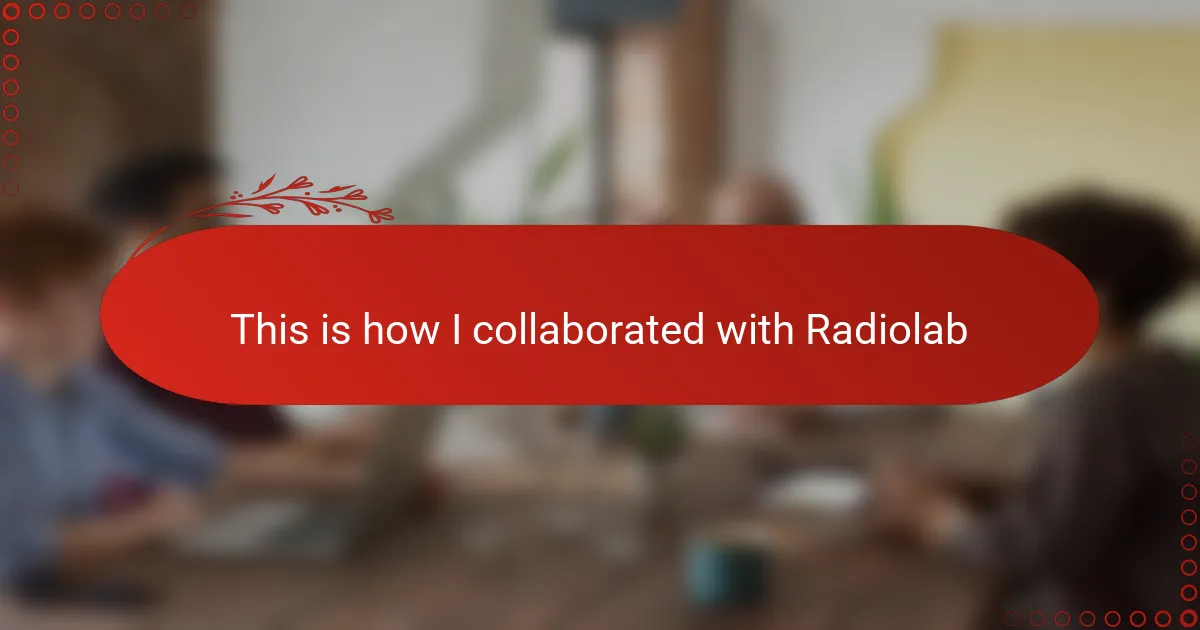Key takeaways
- Radio broadcasting is a unique medium that combines emotion and technology to create a powerful connection with listeners.
- Radiolab’s innovative format encourages creativity and spontaneity, allowing for immersive storytelling through layered soundscapes.
- Effective collaboration requires flexibility, patience, and open communication, especially when working across different locations and time zones.
- Sound layering and careful attention to recording details can significantly enhance the storytelling experience in audio production.
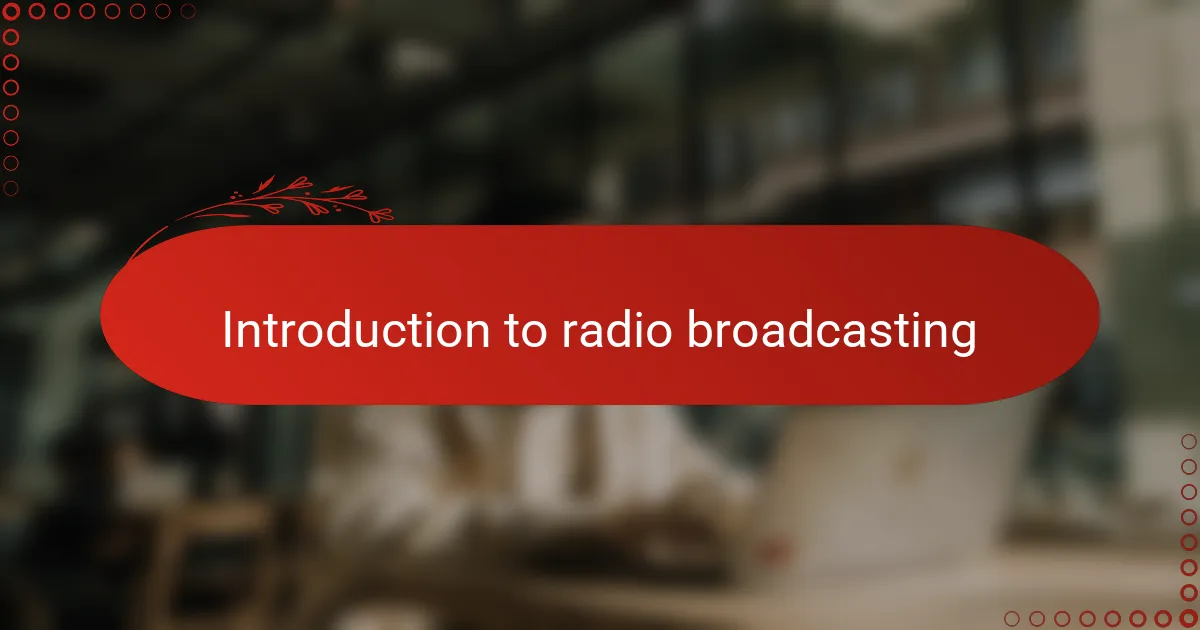
Introduction to Radio Broadcasting
Radio broadcasting has always fascinated me because it turns sound into a bridge between people, no matter where they are. Have you ever wondered how a single voice or story can travel miles and then suddenly feel like it’s speaking directly to you? That magical connection is exactly what drew me into the world of radio early on.
From my experience, radio isn’t just about delivering information—it’s about crafting an experience with tone, timing, and silence. I remember the first time I heard a broadcast that truly pulled me in; it wasn’t just the facts but the emotions behind the storyteller’s voice that made me pause and reflect. This emotional power is why radio remains such a uniquely intimate medium even in our digital age.
What strikes me most about radio broadcasting is its blend of art and technology. Behind every segment lies a careful orchestration of sound design, editing, and narrative flow. It’s like painting a picture with waves of sound, creating moments that listeners can’t just hear but feel. Have you experienced that feeling when a broadcast suddenly makes you see the world differently? That’s the essence of radio’s lasting impact.
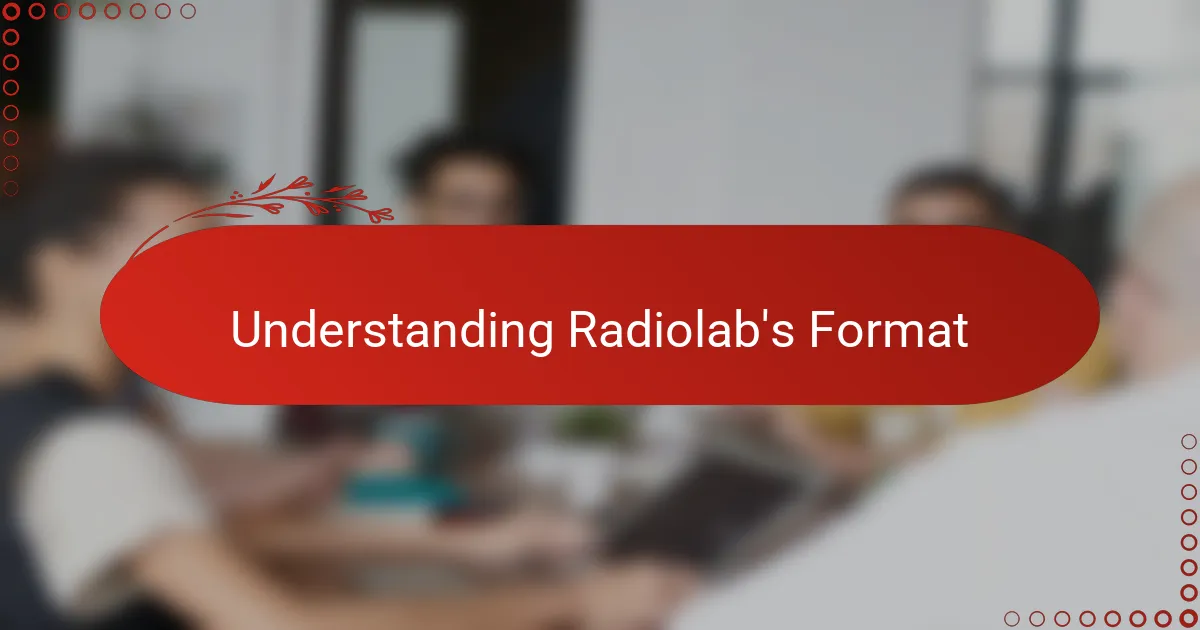
Understanding Radiolab’s Format
Radiolab’s format immediately caught my attention because it breaks away from traditional radio storytelling. Instead of a straightforward narrative, it uses a mix of interviews, soundscapes, and playful editing that feels like a conversation rather than a lecture. Have you ever listened to a program where sounds almost become characters themselves? That’s exactly what Radiolab does so well.
What I find truly inspiring is how Radiolab layers seemingly unrelated sounds and ideas to build a complex, immersive experience. It’s like peeling back multiple layers of a story, each revealing something unexpected. When I first heard one of their episodes, I was struck by how seamlessly science and emotion blended, making complex topics feel deeply human.
Understanding this format changed the way I approached collaboration. Radiolab isn’t about rigid scripts; it thrives on curiosity and spontaneity, inviting you to experiment with sound and storytelling. It makes me wonder—what happens when you let creativity lead the way instead of just relying on facts? For Radiolab, that question shapes every episode they create.
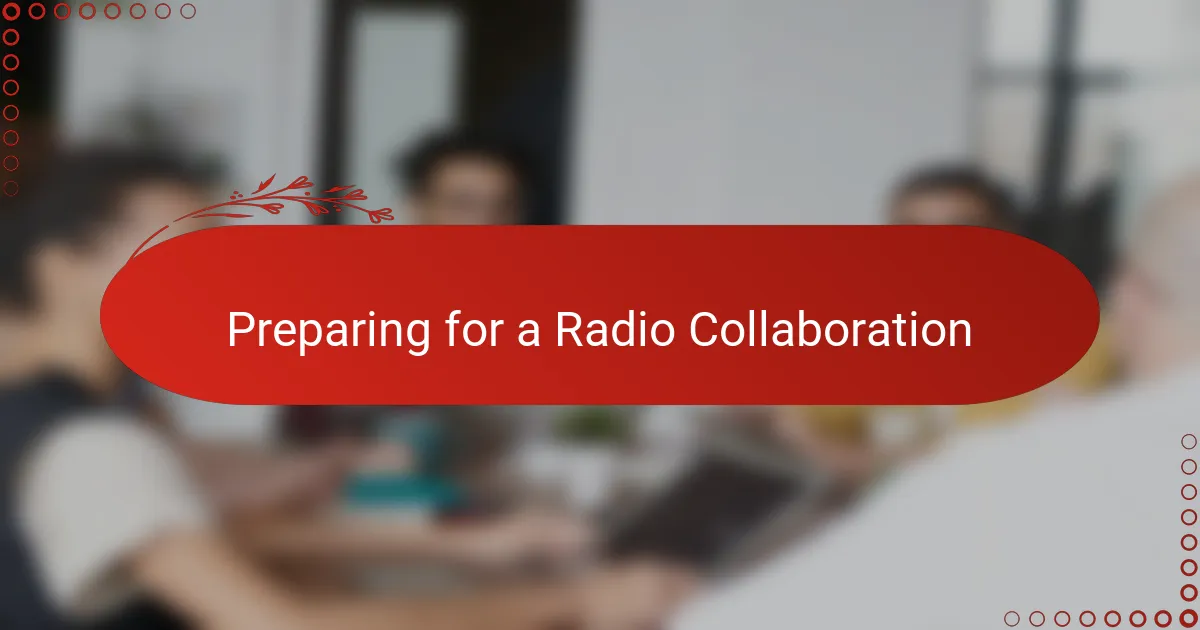
Preparing for a Radio Collaboration
Preparing for a radio collaboration, especially with a team like Radiolab, means tuning into their unique rhythm before you even start recording. I found myself replaying episodes, not just to enjoy them but to decode how they layer sounds and stories. Have you ever tried to catch the subtle ways voices overlap or how silence sneaks in to emphasize a point? That kind of attentive listening became my first step.
Next comes the challenge of aligning creative visions. I remember feeling a mix of excitement and nervousness, wondering how my ideas would mesh with Radiolab’s spontaneous style. Rather than scripting everything rigidly, I learned to embrace flexibility—asking myself, “What if I let the story unfold naturally, even if it means taking unexpected detours?” This mindset shift was crucial in preparing for the collaboration.
Finally, technical preparation can’t be overlooked. From my experience, ensuring your equipment captures the nuances of sound just as vividly as Radiolab does made a big difference. Have you considered how the quality of a single recording can transform the listener’s experience? For me, this attention to detail was as important as the storytelling itself.
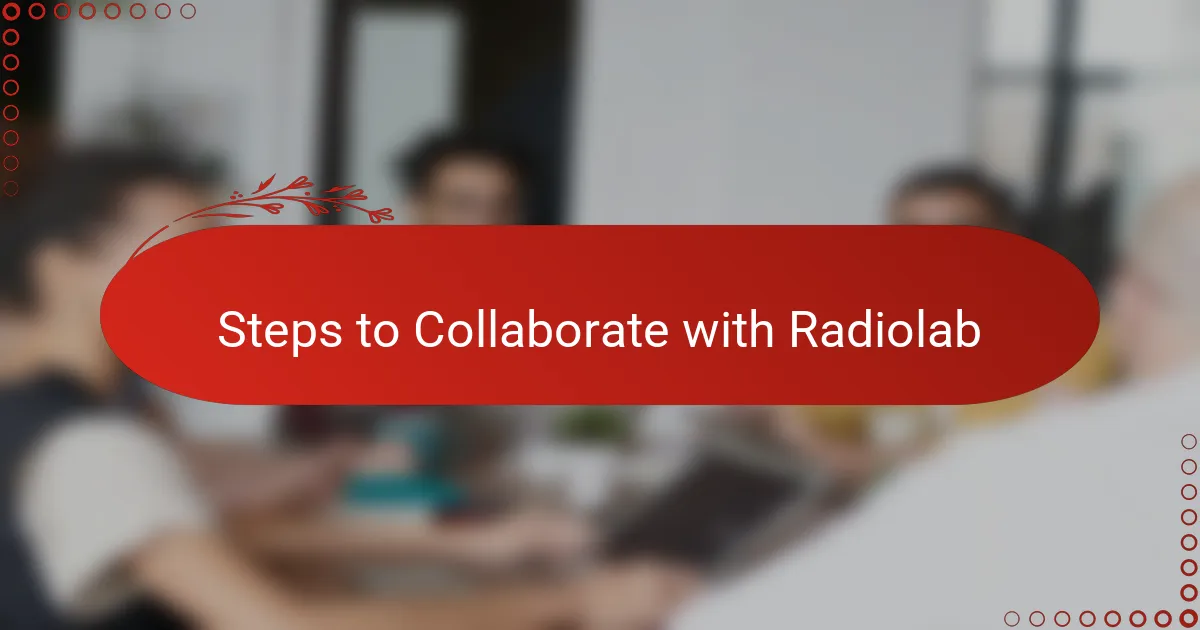
Steps to Collaborate with Radiolab
Figuring out how to approach Radiolab felt like decoding a secret language at first. I started by reaching out through their official contact channels, pitching ideas that matched their curiosity-driven style. Have you ever sent a message that you hoped would spark a creative spark? That initial connection is where collaboration begins.
Once communication is established, the real dance starts—listening closely to their feedback and shaping your story idea together. I found myself constantly adapting, trying to match their fluid approach to narrative while keeping my voice authentic. It’s like learning a new rhythm; sometimes you lead, sometimes you follow, but always you stay attuned to the music of collaboration.
Scheduling recording sessions and sharing raw audio was another step where patience paid off. Radiolab’s team encouraged experimentation, which meant embracing imperfections and surprises in the sound. Have you noticed how the best stories often come from unexpected moments? Letting go of control and trusting the process was, for me, the key to a successful partnership.
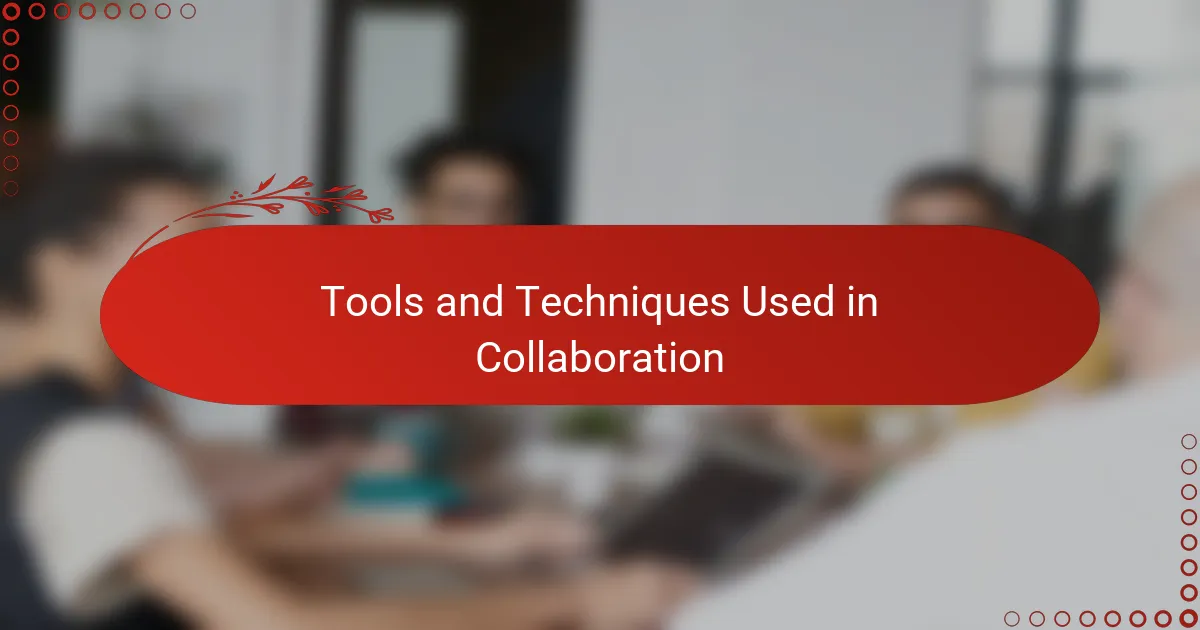
Tools and Techniques Used in Collaboration
When collaborating with Radiolab, I quickly realized that digital tools like shared cloud folders were indispensable. They allowed us to exchange large audio files and drafts seamlessly, which kept our workflow smooth despite being miles apart. Have you ever tried sending hefty sound files by email only to get frustrated? This was a welcome upgrade.
Beyond the tech, the techniques Radiolab employs fascinated me—especially their use of layered editing. I learned to think of sound like a canvas, blending interviews, ambient noises, and music into a single immersive experience. It felt like painting with audio, where every cut and fade carries emotional weight.
Recording techniques also played a huge role in how we worked together. Radiolab’s producers encouraged me to embrace spontaneity during sessions, capturing raw moments rather than hunting perfection. That approach was liberating—it made me ask, “What if the magic is actually in the unscripted parts?” For me, this opened up a whole new level of creativity in sound storytelling.
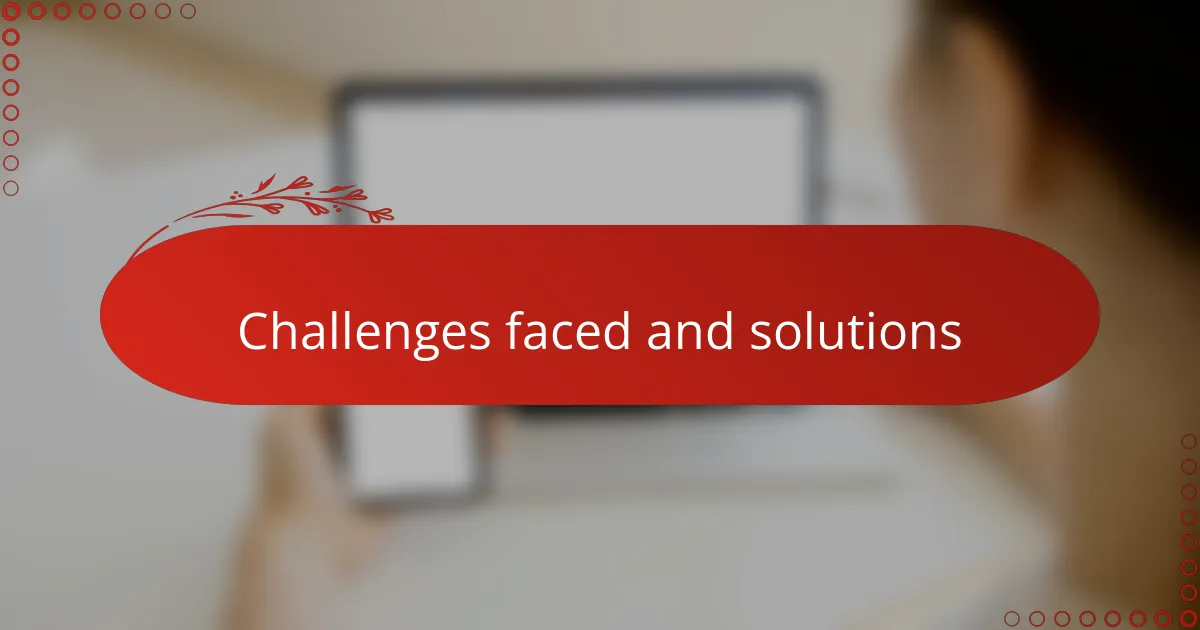
Challenges Faced and Solutions
One challenge I faced was adapting to Radiolab’s fluid, spontaneous style after years of more structured scripting. At first, it felt a bit unsettling not knowing exactly where a story would lead. But I soon realized that embracing uncertainty allowed richer moments to surface—have you ever noticed how the best conversations happen when you stop trying to control them?
Another hurdle was coordinating across different locations and time zones. Sharing large audio files and feedback took patience and a reliable system. Using cloud-based tools made this process much smoother, but it still meant being extra mindful about deadlines and clear communication to keep the momentum going.
Lastly, capturing the sound nuances that Radiolab is known for pushed me to rethink my recording setup. Small details like room tone or microphone placement suddenly mattered more than ever. I remember adjusting and re-recording segments multiple times, wondering if these subtle shifts would really make a difference—but in the end, they brought the story to life in ways I hadn’t anticipated.
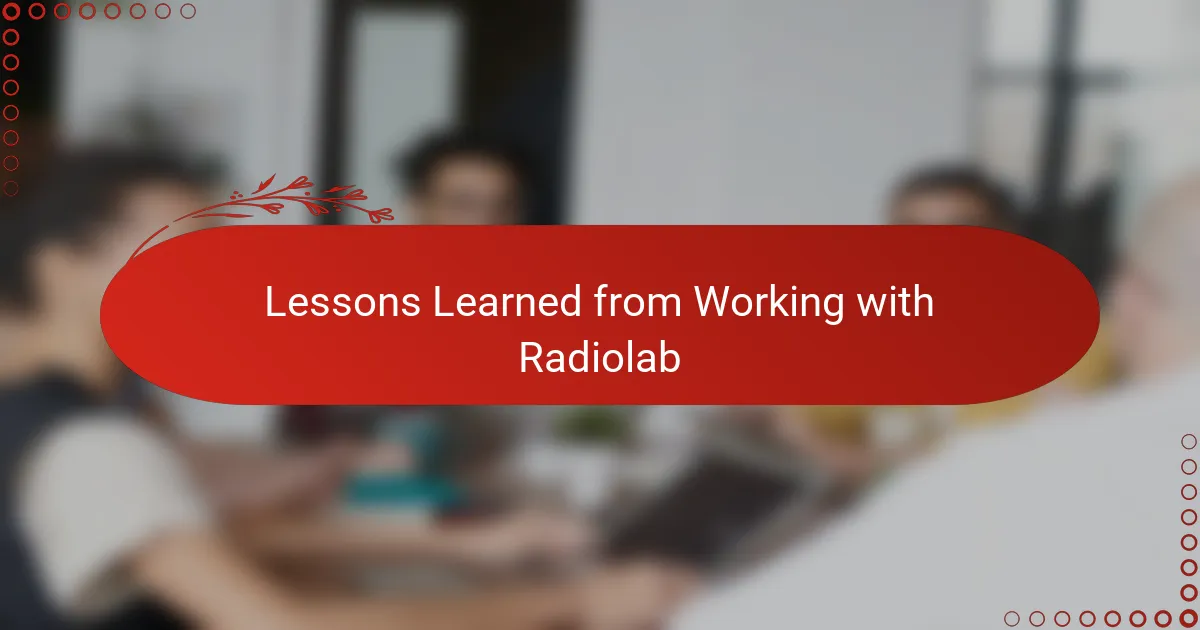
Lessons Learned from Working with Radiolab
Working with Radiolab taught me the true value of flexibility in storytelling. I realized that letting go of rigid scripts wasn’t just freeing—it actually invited moments of unexpected brilliance. Have you ever noticed how sometimes the best parts of a conversation are the unscripted pauses and spontaneous reactions? That openness became the heartbeat of our collaboration.
Another lesson was how powerful sound layering can be when used thoughtfully. Radiolab’s precision in weaving interviews, ambient noises, and music showed me that audio isn’t just background—it’s a storyteller’s palette. I remember sitting in the editing room, marveling at how a subtle background hum could transform a scene’s mood entirely. It made me rethink the emotional potential of every sound I captured.
Lastly, the experience reinforced how important patience and communication are in remote collaboration. Coordinating across time zones and sharing large files was sometimes tricky, but it pushed me to be clearer and more responsive. Have you ever had to wait for feedback and realized that patience actually deepened the trust between creatives? For me, that interpersonal connection was as vital as the technical work.
